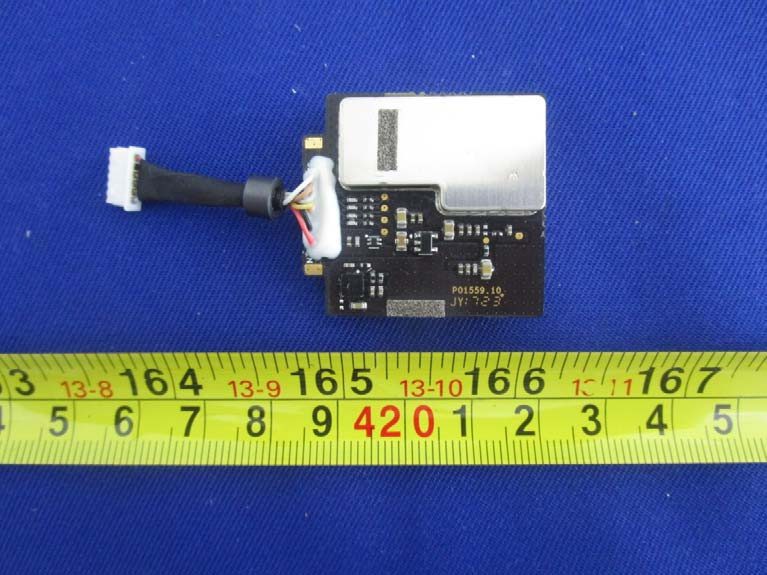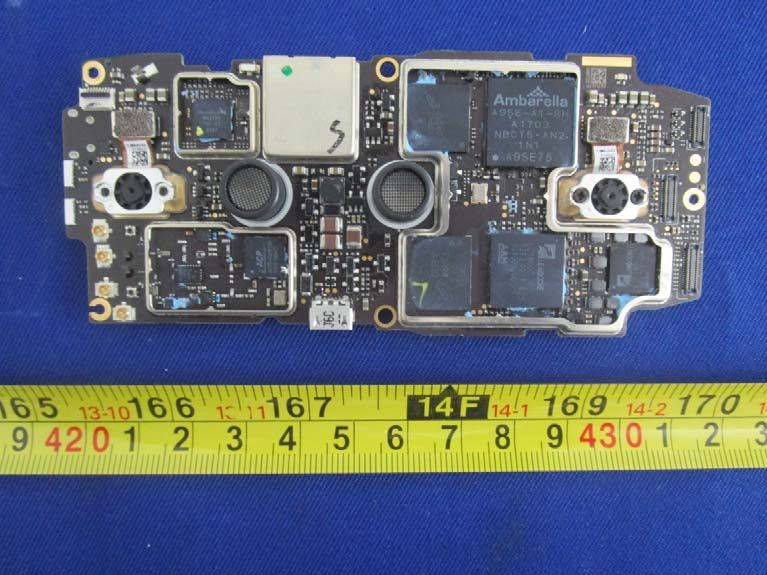Introduction
The DJI M1X, model M1X, represents a new benchmark in consumer and professional drone technology, seamlessly blending advanced imaging, robust flight performance, and state-of-the-art wireless connectivity. As a leader in aerial robotics, DJI has engineered the M1X to deliver reliable and versatile operation for a variety of demanding applications. The device’s recent FCC certification under FCC ID SS3-M1X1708 (grant date: none) signals its compliance with stringent U.S. regulations for radio frequency emissions, ensuring both legal market entry and adherence to safety standards.
This comprehensive analysis delves into the technical heart of the M1X, unpacking its standout features, wireless specifications, and sophisticated internal architecture. We’ll examine the regulatory context of FCC ID SS3-M1X1708, break down its key components through detailed teardown imagery, and provide expert insights into the technology powering this next-generation drone. Whether you’re an engineer, a tech enthusiast, or a discerning consumer, this teardown and analysis offer a rare look under the hood of DJI’s latest innovation.
Key Features & Specifications
The DJI M1X is engineered for robust aerial performance and imaging versatility. Its feature set and technical specifications underline its suitability for both professional and enthusiast users:
Key Features
-
Operating Temperature Range: 32° to 104° F (0° to 40° C)
Ensures reliable performance in a wide spectrum of environments, from chilly mornings to summer afternoons. -
Multiple Still Photography Modes:
- Single shot
- Burst shooting (3/5/7 frames)
- Auto Exposure Bracketing (AEB) (3/5 bracketed frames at 0.7EV bias)
- Time-lapse
-
HDR
Provides creative flexibility for photographers, from high-dynamic-range landscapes to capturing fast-moving subjects. -
Obstacle Sensing System:
Enhances flight safety and automation by detecting and avoiding obstacles in real-time. -
Multiple Flight Modes:
- P-mode (Positioning): Stable, GPS-assisted flight
-
S-mode (Sport): Increased agility and speed
Allows users to tailor flight characteristics to their skill level or mission needs. -
Rechargeable Remote Controller Battery:
Offers convenience and extended operation time for pilots. -
Max Ascent Speed: 5 m/s
Enables rapid altitude changes, beneficial for capturing aerial perspectives quickly. -
GPS/GLONASS Support:
Dual-satellite navigation ensures precise positioning, stable hovering, and reliable return-to-home functionality. -
Max Speed: 18 m/s
Delivers impressive speed for covering large areas or following fast-moving subjects.
Technical Specifications
-
Electronic Shutter Speed: 1/8 – 1/8000 s
Supports crisp stills and smooth video capture, even in challenging lighting. -
Energy: 43.6 Wh
Battery: Intelligent Flight Battery, 3830 mAh, 11.4 V, ~235 g
Max Flight Time: Approx. 25 minutes
Balances flight duration with payload and performance. -
Aircraft Weight (gimbal excluded): 737 g
Lightweight design aids maneuverability and regulatory compliance. -
Camera Specifications:
- Video Recording Modes:
- UHD: 4096×2160 (4K) 24/25p
- 3840×2160 (4K) 24/25/30p
- 2704×1520 (2.7K) 24/25/30p
- FHD: 1920×1080 24/25/30/48/50/60/120p
- HD: 1280×720 24/25/30/48/50/60p
- Max Image Size: 4000×3000
-
Sensor: 1/2.3” CMOS, 12 MP effective pixels
Delivers high-resolution stills and versatile video options for professional-grade content. -
Video File Formats: MP4/MOV (MPEG-4 AVC/H.264)
Ensures compatibility with a wide range of editing workflows. -
Wireless Connectivity:
- Wi-Fi: 2.400 – 2.483 GHz
-
Bluetooth: Present (details not specified)
Facilitates live video streaming, remote control, and seamless device pairing. -
Other Notable Features:
- Robust modular design for ease of assembly and serviceability
- High-density PCB layout for compactness and performance
- Extensive EMI/RFI shielding for signal integrity and reliability
These features position the M1X as a high-performance drone, capable of meeting the needs of aerial photographers, surveyors, and advanced hobbyists alike.
Operating Frequencies
The DJI M1X (FCC ID SS3-M1X1708) leverages multiple radio frequency bands to support its wireless communication, control, and telemetry functions. Below are the specific frequency allocations and output power levels as registered with the FCC:
| Frequency Range (GHz) | Output Power (mW) | FCC Rule Part |
|---|---|---|
| 2.462 | 260 | 15CCC |
| 2.4725 | 908 | 15CCC1.42.412 |
| 2.4775 | 719 | 15CCC1.32.4105 |
| 12.4035-2.4775 | 912 | 15CCC1.22.4055 |
| 15.18-5.24 | 38 | 15E38 |
| 15.745-5.825 | 27 | 15E38 |
These allocations enable robust wireless performance, covering the primary ISM bands used for Wi-Fi, Bluetooth, and potentially proprietary control links. The diverse power levels reflect the device’s need to balance range, data throughput, and regulatory compliance across different wireless applications.
Technology Deep Dive
The DJI M1X is built around a suite of advanced wireless technologies, predominantly leveraging Wi-Fi and Bluetooth for command, control, and video downlink. The supported 2.4 GHz band is a staple for both Wi-Fi and Bluetooth connectivity, enabling reliable communication between the drone, its remote controller, and companion devices. The inclusion of additional bands—potentially extending into the 5 GHz range—further enhances data throughput and reduces susceptibility to interference, which is critical for live video streaming and responsive control.
The operating frequencies and their corresponding power levels are carefully chosen to maximize range while adhering to FCC emission limits. Higher output in the 2.4 GHz range supports extended control distances and robust telemetry, while lower-power bands likely serve for short-range pairing or auxiliary functions, minimizing battery drain and RF congestion.
Internal test reports (as referenced in the FCC documentation) underscore the M1X’s compliance with electromagnetic compatibility (EMC) and RF exposure requirements. These reports typically verify that emissions remain within prescribed limits during all modes of operation, ensuring both user safety and coexistence with other wireless devices. The sophisticated RF architecture, reinforced by extensive EMI/RFI shielding observed in the teardown images, reflects DJI’s commitment to dependable wireless performance in complex radio environments.
In-Depth Internal Component Analysis / Teardown
Main RF/Digital Module with Shielding and Power Regulation
A detailed examination of the internal module reveals a densely engineered PCB, optimized for RF integrity and compactness. The board’s high component density and multi-layer construction (at least four layers) are evident, with prominent metal shielding enveloping the central ICs—likely the main radio transceiver or MCU. Supporting power regulation is provided by visible inductors and capacitors, ensuring clean supply rails for sensitive circuitry. The robust grounding scheme, including stitching vias and extensive ground pours, minimizes EMI and supports high-frequency signal routing. A JST-style connector with strain relief highlights the modularity and serviceability of the design, while the absence of a visible antenna suggests either an integrated or off-board solution. Overall, this module exemplifies DJI’s meticulous approach to RF performance and mechanical reliability in a space-constrained environment.

GNSS Positioning Module Featuring u-blox Receiver
This PCB centers around a u-blox MAX-M8Q-0-10 GNSS receiver, underscoring the M1X’s emphasis on precise, multi-constellation satellite positioning. The shielded section houses the sensitive RF front-end, with a large ground pour and stitching vias to ensure signal integrity and mitigate interference. Power management components—capacitors and inductors—are strategically placed for clean voltage delivery, crucial for reliable GNSS operation. Modular connectors facilitate integration with the main flight controller, while test points along the board edge support efficient manufacturing and diagnostics. The design’s compactness and robust EMI shielding reflect a focus on high-precision navigation, resilience, and field-serviceability.

Fully Disassembled Drone: System Architecture and Modular Design
With the drone fully disassembled, the system’s architectural sophistication comes into sharp focus. The main PCB, likely a 6-8 layer board, is populated with a central SoC or flight controller, memory, PMICs, and supporting logic—an integrated hub for real-time flight, video, and sensor processing. Modular daughterboards, FPC connectors, and coaxial antenna feeds highlight the design’s flexibility and ease of assembly or repair. The presence of multiple antennas, strategically routed within the chassis, suggests support for MIMO or diversity operation, enhancing control and video link reliability. The gimbal and camera assembly, with visible brushless motors and imaging sensor, underscores the M1X’s imaging prowess. Extensive EMI/RFI shielding and robust power circuitry further reflect DJI’s stringent engineering standards.

Video Processing and Wireless Communication PCB with Ambarella SoC
At the heart of the M1X’s imaging and transmission capabilities lies a densely packed PCB featuring an Ambarella A956ET-2M1 SoC—renowned for high-performance video processing. Surrounding the SoC are several BGA memory chips, supporting high-throughput image encoding and storage. Multiple RF connectors indicate external antennas for Wi-Fi, Bluetooth, or video downlink, while extensive EMI shielding and ground pours ensure signal integrity. The board’s multi-layer construction, with controlled impedance traces and differential pairs, enables high-speed data transfer between the processor, memory, and wireless modules. Large inductors and capacitors denote a robust power management subsystem, supporting the SoC and RF circuits. Modular connectors and test points round out a design tailored for performance, reliability, and manufacturability.

Regulatory Insights & FCC Filing
FCC ID SS3-M1X1708 is the official marker of the DJI M1X’s compliance with U.S. electromagnetic interference and radio frequency emission standards. While the grant date is listed as “none,” its registration with the FCC.gov database signifies that the device has undergone rigorous testing and review, clearing it for legal sale and operation in the United States.
FCC filings typically encompass a broad array of technical documentation, including RF exposure and EMC test reports, internal and external photographs, user manuals, schematics, and block diagrams. These documents collectively verify that the device operates within mandated emission limits, does not pose health risks, and will not interfere with other spectrum users.
According to the summarized user manual (User-Manual-3555696.pdf), the M1X provides comprehensive guidance for setup, operation, and maintenance, including detailed instructions for safe battery handling and storage, remote controller functions, and operational safety precautions. These materials not only support regulatory compliance but also promote user safety and optimal device performance.
Potential Use Cases & Target Audience
With its blend of high-resolution imaging, advanced flight modes, and robust wireless connectivity, the DJI M1X is well-suited to a range of demanding scenarios:
-
Aerial Photography and Videography:
Professional and enthusiast photographers can leverage the M1X’s 4K video, HDR stills, and stabilized gimbal to capture cinematic aerial content for commercial projects, social media, or personal portfolios. -
Surveying and Mapping:
The precise GNSS module and long flight times make the M1X ideal for creating orthomosaic maps, conducting land surveys, or performing infrastructure inspections, where accuracy and reliability are paramount. -
STEM Education and Research:
Educational institutions and researchers can utilize the M1X’s modular design and programmable interfaces for robotics curricula, autonomous navigation experiments, or environmental monitoring.
While the official target audience is not specified, the M1X’s feature set and build quality make it an attractive choice for professionals, advanced hobbyists, and organizations seeking reliable aerial robotics solutions.
Conclusion
The DJI M1X (Model: M1X), certified under FCC ID SS3-M1X1708, exemplifies the fusion of advanced engineering and regulatory compliance. Its sophisticated internals, versatile wireless capabilities, and comprehensive safety features position it at the forefront of aerial robotics. The FCC certification ensures legal operation and market readiness, while teardown analysis reveals a device built for performance, reliability, and serviceability. For those seeking a high-performance drone platform—whether for creative, commercial, or research applications—the M1X stands as a testament to DJI’s leadership in drone technology.